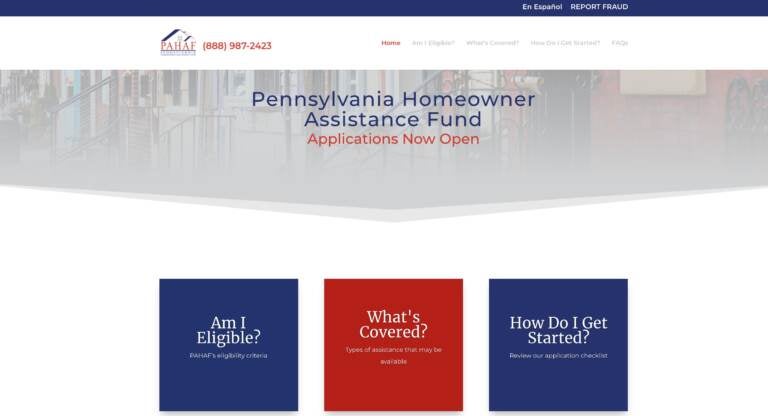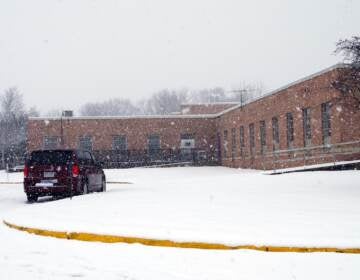Longed-for pandemic mortgage assistance program launches in Pa.
The day the Pennsylvania Homeowners Assistance Fund application portal opened, it crashed, inundated with people trying to register.
Listen 1:45
A screen capture of the webpage for the Pennsylvania Homeowner Assistance Fund. (PAHAF)
The Pennsylvania Homeowners Assistance Fund, pandemic-related financial help for homeowners through the American Rescue Plan Act, launched Feb. 1.
Immediately, it proved to be a hit. The application portal crashed Tuesday, inundated with folks trying to register the first day.
The fund aims to support people affected by the COVID-19 pandemic who are falling behind on their property taxes, homeowners insurance, utilities, mortgage payments, and homeowners association fees. It can assist homeowners with up to $30,000 of need.
The state was awarded more than $350 million in American Rescue Plan funds through the U.S. Treasury Department’s Homeowners Assistance Fund. Homeowners with incomes equal to or less than 150% of the area median income for their household size are eligible. For the Philadelphia region, that means less than $99,250 for a one-person household.
In a tweet regarding Tuesday’s crash, the Pennsylvania Housing Finance Agency said that the fund was “experiencing an unusually high volume of registrations that is impacting user access to the application portal. We apologize for the delay and understand your frustration.”
Paula Powers-Watts, executive director of the Credit Counseling Center in Richboro, Bucks County, a nonprofit that is helping homeowners apply, said the crash was probably because of the long list of people who have been waiting for months to get in, ever since the program was first advertised.
“And then when they got the notice that the program was opening up for the applications, they all did it at once,” Powers-Watts said.
The Credit Counseling Center also has its own waiting list for folks interested in applying for the program.
“We have clients that have been calling every month to see if the program opened up,” said Powers-Watts. “It’s almost unending, the number of calls we get.”
Most of the people the center helps have a forbearance on their homes, or are paying modified mortgages to be able to stay on top of their payments.
“They are really at their wits’ end,” said Powers-Watts. “They are scared, afraid of losing their home, afraid of the uncertainty of the future.”
About 45% of the center’s clients have maxed out their forbearance, and now have no way to make their mortgage payments. Many have had forbearance agreements on their homes for 12 to 18 months.
“So we’re hoping that this program can really help a lot of those families get over the hump,” said Powers-Watts.
Annie Neamand is an attorney who specializes in foreclosure prevention and other homeownership issues for Legal Aid of Southeastern Pennsylvania. About 75% of her cases are related to preventing foreclosures, and she’s hoping to get all those clients to apply for the state Homeowners Assistance Fund.
“I think that it’s so new that some bugs are getting worked out,” said Neamand.
Many of her clients had been holding their breath waiting for the application to go live, she said.
“I’ve had clients saying [to themselves], ‘Just hold on a little bit longer. I think we’re going to have some help in the future,’” said Neamand. “And so it’s finally here, and now we just need to get the word out that it’s here.”
Nelly Jimenez, executive director of ACLAMO, a nonprofit that predominantly serves the Latino community in Montgomery County, has been supporting families displaced by Hurricane Ida and people in need of state rental assistance.
She has concerns about this program’s accessibility, specifically the “technology gap” she sees with her clients, those who don’t own computers, phones, or have access to Wi-Fi.
“That’s where it raises red flags for me,” said Jimenez. “Is this really going to reach the people that need it the most?”
ACLAMO is already inundated with folks in need of rental assistance. According to Jimenez, they don’t have the necessary support to assist those with the homeowners application.
“We just don’t have capacity,” said Jimenez.
She suggested that the state offer financial assistance and training to grassroots organizations to help those who need the funds, get the funds.
“We know by now that this doesn’t work unless you engage the people in grassroots organizations, right?” said Jimenez. “Because again, who’s going to take advantage? The people who can.”
William Kampf, 88, from Croydon in Bucks County, will be receiving assistance through the Credit Counseling Center to apply for the aid. Kampf has a $6,000 lien against his home.
His home mortgage was in forbearance, but he was able to eventually arrange for a modified mortgage payment.
When he first learned about the application for the Pennsylvania Homeowners Assistance Fund, or PAHAF, he was concerned about being able to access the assistance.
“How can I do anything like that? I don’t have a computer. I can’t afford one. I can’t get a phone,” said Kampf.
A retired plant manager at Tri-State Container now living on a fixed income, Kampf has been in and out of the hospital for the past year, suffering from a hernia and congestive heart failure. He’s struggling to pay his medical bills.
“I don’t have it. You can’t get blood out of a rock,” said Kampf.
On top of it all, his house was flooded in the “100-year-flood” last July, and trees fell on his property after the remnants of Hurricane Ida hit the area in September.
“I’m down without no money,” said Kampf. “I ran my credit cards up because I had to live. I had to pay. I had to do what I could. And my fixed income was getting whittled down with the bills and everything else. So what am I going to do? What can I do?”
Powers-Watts is concerned about the Pennsylvanians who have debts over $30,000, those with balances exceeding the criteria of the program.
“There are going to be some folks who are just not going to be able to get any of the assistance because of the default,” she said. “If the default is $56,000 and $30,000 is paid, what’s going to happen with the remaining default balance? So the house could still go into foreclosure.”
In response to this concern, the state Housing Finance Agency has said it will cover $30,000 and homeowners will have to contribute “enough funds or document an approved loss mitigation plan to cover the additional need beyond the PAHAF cap.”
Both Powers-Watts and Neamand are still encouraging their clients to apply, even if they exceed the $30,000 limit.
“The PAHAF needs to see that people are having these problems and need more than the cap,” said Neamand. “They’re not going to notice to fix that issue unless people are showing them that it is an issue.”

Show your support for local public media
WHYY is your source for fact-based, in-depth journalism and information. As a nonprofit organization, we rely on financial support from readers like you. Please give today.




![CoronavirusPandemic_1024x512[1]](https://whyy.org/wp-content/uploads/2020/03/CoronavirusPandemic_1024x5121-300x150.jpg)



